Subsystem 1: Content Creation
Subsystem 1: Content CreationThe first subsystem of the modernized training system is the machinery to develop translatable multi-media training material that can be used for training all personnel across the country. The material developed needs to be:
- standardized and translatable(to ensure consistent messaging/ practices) accessible openly in an electronic form
- reusable (the same training content can be used for overlapping needs for different cadres)
- easily updatable (to allow easy change of standardized content)
This component is built to include all stakeholders that delevelop training material, ranging from national institutions, technical and programmatic experts, to instructional learning experts and digital media creators. They all need to follow uniform processes to interact and produce training material, spanning all of NTEP operations, in a consistent manner, maintaining a high level of quality.
The system of content development will be made of three parts, the Knowledge map, the Page Library and Training Courses and curricula.
1. The Knowledge Map:
The entire universe of ideas/ concepts required for training in NTEP has been visualized as a map called the ‘Knowledge map’. Each unique idea/unit in the Knowledge Map is called a ‘node’, which serves as a building block to the entire training content development process.
2. The Page Library:
For each node on the knowledge map, standardized training content is built as a Page. A page is expected to impart training related to the learning objectives defined on its knowlege node, in a maximum duration 3 mins. While developing the page, questions related to the learning objective are also defined. Each page is translated into necessary language versions. Pages for all the knowledge map nodes are available in the “Page Library".
Development of pages will include:
- Understanding learning objectives and gathering technical material
- Designing/ redesigning the instruction/ digital content for each page using various media (Text+/- images, Audio/ Videos, interactive animations etc) based on feedback from the end-users.
- framing questions associated to the various learning objectives and adding them along with the page
- translation of select pages according to need/feedback from the end-users
3. Course/ Curriculum Development:
Pages drawn from the Page library will serve as building blocks for designing training curriculum or “Courses”. Any number of Courses can be prepared by grouping/ structuring the pages from the Page Library in a sequence. The grouping/ selection of various pages and their sequencing will address all varieties of training needs for different cadres. Pages are organized under chapters in a sequence; chapters are in turn organized under modules and later modules are organized into Courses. Courses will be used to implement training.
This model where the training content development is divided into three parts, allows adherence to the initial principles of reusability, standardization and ability to be kept updated. Through the knowledge map there is a comprehensive understanding of the various current knowledge/ training needed in NTEP and becomes a repository of the same. The content in pages is standardized for use across the country. The availability of individual pages allows it to be reused in multiple training courses for different cadres; and allows individual pages to be updated, whereby the courses using these pages can be automatically updated with the latest information or upgraded into a more engaging and prioritised way.
The Pre-test , intermediate quizzes and post-test also constitute an important component of the course curriculum. These quizzes are composed of selected questions drawn from the question bank generated from the pool of questions linked to each page added to the course.
The processes related to all the three components described above are carried out in the online tool built for this subsystem called the Knowledge Base.
1.1 The Knowledge Map
1.1 The Knowledge MapThe first component of the Knowledge Base is a map of all ideas that need to be imparted to a trainee in NTEP. This section describes the various concepts, principles, roles and processes related to maintaining and updating the knowledge map.
Concepts
-
KMNodes(Knowledge Map Nodes) :
A KMnode may be a unique concept, process, idea, definition, algorithm, or any other aspect with a specified learning objective.
-
Relationships:
The KMnode will have defined relationships with other KMnodes which may further detail or explain the concepts or describe a higher-level concept.
For example, there will be a node defined for the concept of ‘ZN microscopy’ and it will be related to further nodes such as ‘staining’, ‘smear preparation’ and so on, or link ZN microscopy and Fluorescent microscopy through the overall concept of ‘Microscopy’ in general. Thus, the nodes and their relationship will exist as a network / map where there is no defined hierarchy. The hierarchy will dynamically be identified when a trainee or training need is defined.
The KMnodes have the following attributes:
Table 2: List of Attributes of the KMnode
| Attribute | Description |
| ID | This is a unique identifier for tracking the nodes in the knowledge map database. |
| Name | Title of the page. This should be able to identify the unit sufficiently and its difference to other pages should be clearly evident. |
| Description/ Learning Objective | Provides short synopsis of what the content associated with the unit should cover. |
| Maintainer | Name/ UserName of the expert who is currently responsible for the maintenance of the node and its related training content. The maintainer has to ensure that the node and its content are in line with the principles of the knowledge map and with the current guidelines/ directives. |
| Relationships |
Describes the relationships of the node to other entities. This will include entities such as
|
The current version of the Knowledge Map can be viewed from the link. The knowledge map here is represented as a list of nodes linked with other units in the knowledge map.
Principles of the knowledge map
- Idea/ concept centric- Non audience dependent: The KMnodes and their learning objectives linked to it represent one defined idea/ concept.
- Unique Unit Based: A learning objective will only be represented in one and only one node.
- Complexity in division: In cases where the concept or topic to be discussed has many aspects, a single node may be used to represent the overall concept in brief, while specific details or in depth concepts may be presented in other nodes.
- Dynamicity, Organic and iterative evolution: The knowledge map is meant to be a dynamic collection of nodes, where new nodes are constantly added with new program areas/ expansion, older nodes updated with changes in program structure and deleted with outdated concepts/ideas being removed. These changes are to be made in real time as and when the program update/ change happens.
Roles
- Maintainer: The maintainer is a person/ expert who is responsible for maintaining the integrity, comprehensiveness and quality of the knowledge map and ensuring adherence to the above described principles. The maintainer may perform additions, modifications, and depreciations(Deletions) of nodes on the knowledge map. There may be many maintainers organized into a committee/ group and may be collectively responsible for the knowledge map. Each maintainer may be assigned a group of nodes to maintain. All nodes will mandatorily need to be assigned to a maintainer.
- Content Creator: Content creators are people who develop training content for each KMnode on the knowledge map. A content creator may be assigned a node to develop content against. However, they only have view permissions on the knowledge map; but may be able to respond to comments made by anyone on the nodes assigned to them.
- Others: The knowledge map being open content, all users(including the above two) may have access to view the entire knowledge map. They may suggest new nodes on the knowledge map and add comments/ suggestions on existing nodes. New nodes will need to be approved by the assigned maintainer before it is published on the knowledge map. Each newly added node will also be assigned to any one of the maintainers.
Processes
- Add new node:
- Submit draft node: Any visitor on the knowledge map may suggest addition of a new node. New nodes need to be linked to any one existing “Parent” node and will be first added in a Draft mode. The maintainer of the parent node will be assigned to the new node. The visitor adding the node needs to fill in all the attributes of the nodes mandatorily.
- Review by Maintainer: New nodes added in Draft mode will be notified to the Maintainer, who will review the node and will perform the following actions
- Approve the new addition after it passes the following checklist. If the node does not pass it; the maintainer may outright reject the draft node or modify the attributes till it passess the checklist.
- The name of the node and the learning objective are clear and precise. For example, “Burden” is an unclear title; while “Burden of TB in India” is clear and precise.
- There are no other nodes in the knowledge map with overlap/ have duplicate learning objectives with the new node added.
- There is a training need that is attributable to the new node. For, example; in NTEP training, “Manufacture of 3FDC” may be considered as out of scope of training.
- Assign a different maintainer. The existing maintainer may judge that the node is better dealt with by a different maintainer, he/she may assign it to a different maintainer in the maintainers group.
- Approve the new addition after it passes the following checklist. If the node does not pass it; the maintainer may outright reject the draft node or modify the attributes till it passess the checklist.
- Publish the node: Approved new nodes get published on the knowledge map.
- Submit draft node: Any visitor on the knowledge map may suggest addition of a new node. New nodes need to be linked to any one existing “Parent” node and will be first added in a Draft mode. The maintainer of the parent node will be assigned to the new node. The visitor adding the node needs to fill in all the attributes of the nodes mandatorily.
- Update existing node:
- Maintainers of the node may update any of its attributes except the unique identifier. All changes to a node will be tracked as different versions of the node. The update may be performed for the reasons such as:
- Update in Name/ Learning objective: The update may be triggered by various needs/ events, such as change in policy/ guidelines; any error identified on the learning objective or better understanding of the purpose of the node.
- Adding/ changing node relationships: The maintainer may identify new connections with existing nodes on the knowledge map.
- Re-assigning maintainers: The existing maintainer may assign a node to any other maintainer on the maintainers group.
- Maintainers of the node may update any of its attributes except the unique identifier. All changes to a node will be tracked as different versions of the node. The update may be performed for the reasons such as:
- Depreciate existing node: Any existing node may be depreciated when the node/ learning objective becomes outdated or no longer relevant. Such depreciated nodes effectively get removed from the published knowledge map.
- Commenting/ Discussions: Any visitor on the knowledge map may comment/ provide suggestions on any of the existing nodes. Comments may be reviewed/ replied to by the node maintainer/ the content creator assigned to that node.
1.2 Content Development
1.2 Content DevelopmentConcepts
-
Content Page:
A Content Page is a unit of training content that expresses the learning objectives on a KMnode on the Knowledge map. There will be one page of training content for every KMnode in the knowledge map. The content on each page is based on technical training material / SOPs / guidelines of NTEP and may explain or demonstrate it in more detail. In addition to the training material itself, the Content Page will also have certain additional details/ materials such as
- references to source documents or other credits/ acknowledgements
- attachments
- quick reference/ job aids/ posters
- raw editable versions of images/ graphics/ videos used in the main content.
-
Page Types:
Based on the type of material that is used on the Content Page, it is classified into various types. The list below is ordered in ascending based on the level of effort needed to create the page.
- Basic Page: These are pages that are built using simple text and images. The text and images may be based on content available in any existing guidelines/ documents/ training material, as per the needs of the learning objective on the linked KMnode. The Basic page should at least serve the needs of training delivered in an instructor led mode.
- Improved Basic Page: Basic Pages may be redone, to explain the concept in a better way using better graphics/ text, either by changing the way of representation (infographics), or by including examples / cases etc. This would improve the ability of the page to deliver the learning objectives to a level such that the trainee may read and understand the concept without any instructor.
- Video Lecture: This type includes where the content is a video of an expert explaining the concept in his/her own words in alignment with the learning objective. The delivery of the training will rely on the expert's ability to present the content in an easily understandable way. The video may use a slide deck with a video inset of the presenter, or a writing board/ background image along with the presenter. The voice of the presenter may be scripted and subtitled along with the video.
- Animation: These are pages with simple animated content in a video format. This page type may be used in cases where learning objectives may be delivered better using a schematic/ moving representation of the concept as opposed to other ones. For example, simple workflows involving different locations and people over time. This type excludes animations that can be created easily by tools such as power point and recorded as a video, and is meant to classify animations that require a professional animator to create it and is often commissioned. The content creation involves multiple stages such as scripting, key frame/ scene review, draft review, and final review and approval.
- Video Demos: These pages contain content that are video shots of actual locations where a procedure or a protocol is demonstrated. Here too the content creation involves multiple stages such as scripting, casting, field shooting, editing, draft production review, and final review.
- Interaction and Games : These are pages with many different types of user interactions, such as clicking, drag & drop, text entry and so on. It uses a combination of different types of raw material to achieve a learning objective including videos/ animations/ demonstrations and narration as needed. The interaction may require the user to apply the knowledge obtained to achieve and reinforce the learning objective. It may have one start point, but may branch out into different scenarios based on user interaction, with many end-points that may backtrack and re-join at different places. This page type may be used when the learning objectives are complex, with decisions/ judgements that need to be made. For example constituting a DR-TB Drug regimen for a given diagnostic scenario. The content creation involves multiple stages such as concept scenario design, scripting, key frame/ scene review, interaction testing, and final review
In cases where combinations of types are included in a page, the more complex type will be considered; for example, a video recording of an expert with an animation will be classified as an Animation.
The page may undergo evolution / upgradation with time based on changes in the program or based on need for better content representation. The page types will assist the upgradation process. The Basic Page type is the most easiest to create and is often the first created type. Based on the material on the Basic Page, which ensures basic technical accuracy of the training content, future upgraded versions of the page may be created.
-
Question
Based on learning objectives of a page and the training content placed in it, one or more questions may be added/ linked to the page. These will serve to assess whether a trainee has acquired the necessary knowledge/ understanding expected. The questions will usually be of multiple-choice type.
Principles
The broad principles that have to be followed while developing a page are as follows:
- Self contained/ independent: The training content on a page should be self contained and should not be built on the context of content available on any other page or continue from another page.
- Specific to learning objectives: The page should be able to deliver the learning objective without having to refer to another page and should contain only content specific to the learning objective of the knowledge map node linked to the page. There should not be any content included for the purposes of introduction or conclusion.
- As simple as possible: It should be possible to use any page for the training of any personnel. Hence the technical content should be explained in simple language as far as possible.
- Delivered in 2-3 minutes: It should be possible for the average trainee to consume the training content present on a page in 2-3 minutes.
Roles
- Content Creator: These are personnel that will create content against the Knowledge Map node assigned to them.
- Maintainer: The maintainer for a page is the same as the maintainer for the corresponding knowledge map node. The maintainer reviews and approves pages before it is to be published. He/she also is responsible for deciding the page type to be used while upgrading the page to a higher level page.
- Trainees: All users are by default Trainees. Trainees access the page through one or the other training curriculum. They may provide feedback at the level of a page through the comments on the corresponding linked knowledge map node.
Processes
Note: Upgradation and Modification of a page will be considered as a new version of the same page, with the same unique identifier. Older versions of the page may be available at the back end of the LMS and may be accessed on special demand.
- Creation:
- The content creator assigned to a knowledge map node will create the corresponding page and its content. He/She may interact with the Maintainer to identify learning objectives, source documents as required and prepare the training content before creating the page. On page creation the status of the page will be “Pending Review”
- Pages that are of the status “Pending Review” will be evaluated by the maintainer of the page/ corresponding knowledge map node. The maintainer may approve or reject pages based on whether it clears the following checklist
- Alignment of titles- The page title and the corresponding knowledge map node should have the exact same title.
- Specificity of content: The page content needs to be specific to the title and the learning objectives of the corresponding linked knowledge map node. It should not convey any message that is or may be represented in another page.
- Content independence: The content developed on the page should not be in the context of any other page and it should convey the learning objective completely.
- Simplicity: Generally any learned reader should be able to read and understand/ consume the content and its learning objective without additional reference/ reading.
- Duration: It should be possible to consume the content by an average reader within approximately three minutes. In exceptional cases it can be longer.
- Questions
- If the page does not pass the above checklist and is rejected by the maintainer then it will be converted to the stage “Pending Modification”. It will be passed back to the content creator for addressing the comments/ reason for rejection.
- The page will also need to be marked as “Pending Modification” once the corresponding KM Node (Title or learning objective) is updated.
- Modification: Pages that are with the status “Pending Modification” may be reviewed by the content creator and he/she may make changes as per the requirement/ comments.
- Upgradation: A page whose content has not been performing as well as expected and there is a scope to improve the delivery of the learning objectives by using another type of page, it may be tagged for upgradation. Once a page has been tagged for upgradation it will be available to the content creator in an upgradation queue.
- Translation: Certain pages after being built into courses for specific cadres who are less likely to understand English, may be tagged for translation into another regional/ local language. Once it is tagged for translation it will be available to the content creator in the Translation queue.
- Deletion: Page deletion only occurs when the corresponding KM node is depreciated. Such deletions may also be available on the LMS backend, but are not available for viewing.
- Prioritization: Individual pages depending upon the need to make available the published version it will have a certain priority value. Priority value of 10 means highest priority for content development, while 0 means least or no priority. The content creator may pick up pages from a queue for modification/ translation based on the order of priority. The maintainer of the page has the rights to set the priority of the page.
1.3 Curriculum Development
1.3 Curriculum DevelopmentConcepts
-
Course: A course is an organized sequence of sessions containing Pages, demonstrations, practicals, field visits, role plays, quizzes, Pre-test and Post-tests, which will be used for the training related to the program. A course is always specific to a cadre of staff, with a define role and specified competencies under the programme. A course should comprehensively cover all training requirements of that cadre.
Each course will have pages organized under the Page ---> Chapter ---> Module structure. Different courses will have different pages, but they may also use the same page as per the requirement of the course (which is linked with the same knowledge unit or node, and hence based on the same training need). This is depicted in the following schema:
Fig: Course structure
Each course will have a number of attributes as outlined below.
Course ID This is the unique identifier assigned to the course at the time of creation. Title: The course will be named according to the cadre it is intended to train. Eg. Course for Treatment Supporters on NTEP Course Description This is a short description of the course, which will outline the objectives of the course and the topics covered under it. CourseStructure The course structure will contain the data regarding the linkage of the various pages organized under chapters/ Modules and the corresponding quizzes at various stages within the course/ Module/Chapter. Intended Cadre This will indicate the various cadres eligible to take the course. Status This will indicate the status of the course in terms of whether it is in draft stage/ unpublished or published status. It may also include statuses such as depreciated. CourseMaintainer This is the person assigned to this course as the maintainer. -
Module: A module is created for a specific knowledge / functional area which is to be covered for a cadre based on the course objectives. A course may have different modules (knowledge areas) with different pages. For example, in the course for a Lab Technician, “ZN microscopy” may be a module.
NOTE: Modules may also have independent existence outside a course as well. These may be used for imparting a new knowledge area as a part of new expansion in the program or may be used for re/update training.
- Chapter: Chapters will be the topics that are to be covered under knowledge areas (modules). As above, there may be different topics (chapters) under each knowledge area (module). For example, in the module on Microscopy, “staining using ZN technique” may be one of the chapters. Chapters will hold the standardized learning material in the form of pages.
- Quiz: Courses will have quizzes at various stages (pre / post at the level of either course, module or chapter). The quizzes are created/ drawn from the questions attached to the pages that are contained within the course/ module/ chapter. The quiz, depending on how it is set up, will randomly draw questions from a set of questions that were associated with the pages. Based on configuration set by the course creator, the learners must pass/ clear the quiz to proceed and eventually complete the course and earn the certificate. The number of questions in an assessment and passing marks for each assessment will be set at the time of configuring the course/ module as per the need of the training. In the future a quiz may also be manually assessed/ scored.
- Certificate: Each course / module at the end or at achieving completion of the post-test successfully will have a certificate. The certificate is awarded from NTEP, and / or relevant institutions / stakeholders. A sample certificate has been provided in the Annex.
- Webinar: a webinar or an online training session would be scheduled inside the course whenever a remote facilitator would interact with the trainees for any particular purpose inside the course. This could be to deliver an instructor led session, conduct discussions or clarify queries.
Principles
The broad principles to be followed while creating a curriculum/ course are as follows.
- One cadre One course- At a time in the training system of NTEP a specific cadre/ designation will only have one active standard course. A course should be comprehensive, such that it allows all necessary content required to successfully execute the TOR/JD of the corresponding cadre. The monitoring of the training status of a trainee will be considered as Trained/ Untrained under his/her cadre based on whether he/she has successfully completed the single course for that cadre. The individual may undergo modules that are independently available outside his/her course and will count as additional credit.
- Logical flow in sequencing of content: The training content will have to be placed in a sequence within the course. The pages will be sequenced within a chapter, followed by Chapters into Modules and finally modules into Courses. This sequence depending upon the intended audience/ cadre will have to be selected and ordered to ensure that both the appropriate high level concept is introduced and necessary in depth concepts are also discussed afterwards.
- Inbuilt pre/ post test : All courses should have an inbuilt assessment mechanism to objectively identify whether he/she has completed the requirements/ gained all necessary knowledge and skills expected from the course.
- Standard schedule: The course may be executed/ operationalized as per the convenience of the institution; however a standard scheduling pattern may be set.
Roles
- Content creator - The content creator(described above) will also double up as the course creator/ curriculum designer. They will select and organize the pages prepared into chapters> modules> Courses in a sequence appropriate to the cadre. The content creator can create the course in unpublished form.
- Maintainer - The maintainer may review the draft/ unpublished courses and publish them. They may also unpublish existing courses and send them for revisions to the content creator or depreciate them altogether.
- Operational Roles
- Course Coordinator - The course co-ordinator at various states/ STDCs will schedule the various courses according to the plan and training needs of the state and coordinate the conduct of the course
- Trainee - The trainee may access the course if he/she is one of the cadres for which the course is listed
- Facilitator - Facilitators may access the course when it is scheduled and he/she is added to that schedule as a facilitator.
Processes
- Create a new course: Once pages are available, a content creator may organize the pages into a course. After the Type A0 page is approved and published on the CTD e-learning platform, it may be included into a course.
- Review and Approval of the course: Once the course is configured, approval from CTD and other stakeholders will be sought. A meeting of relevant stakeholders will be called to discuss feedback and will be documented. Relevant changes will be listed and made by course creator,
- Set up the course evaluation: As described in the previous section a course will have pre / post evaluation at the level of either course, module or chapter, randomly drawn from the questions attached to the pages that are contained within. The number of questions in an assessment and passing marks for each assessment will be set as per the need of the training in consultation with the relevant stakeholders.
- Configure the course certificate: A certificate for successful completion of the course will be awarded to the participants based on their performance in the course evaluation. The certificate will be designed with appropriate logos of the awarding organizations and will be decided based on consultation with the relevant stakeholders. A sample certificate is provided in the Annex for reference.
- Setup the feedback form: two types of feedback for a course will be sought from the facilitators and trainees:
- Performance or retention of knowledge / skills from the course / module.
- Qualitative and Quantitative feedback from the end users on various aspects of the course/ module.
- Scheduling the course: Generally, once a course is configured, it needs to be scheduled for it to be accessible to trainees. Scheduling a course involves setting the start and end date for the course, adding webinars, contact sessions/ evaluations, adding facilitators, enrolling participants etc. The scheduling is done by the course coordinator based on the training plan.
Style Guide
Style GuideThe style guide provide reference to what standard styles should be used while developing content. This would ensure uniformity of content appearance and will ensure that the trainee would identify the content as belonging to a whole. The style guide would specify standard content styles that can be applied to online content. This would include the following. ( Click the item to read more.)
- Formatting Guide - (Note: Work in Progress)
- Basic Color Palette
- Text (Headings, Bullets and numbering, Quotes, Captions)
- Tables
- Images(Pictures/ photographs/Graphics)
- Library of standard graphics
- Videos and Animations
- Language Guide (TB inclusive Language)
Formatting Guide
Formatting GuideEnsuring consistency and professionalism in the content on the platform is crucial for an effective learning experience. Adhering to specific formatting guidelines helps maintain clarity and coherence in the content.
File Location: Search for specific course materials or content pages within knowledge base platform. It involves navigating through various parameters or criteria to pinpoint the desired information. In the context of our platform, locating a file entails searching for a particular content page based on factors such as page ID, title, status, creator ID, or tags.
- Page Library: The Page Library provides a means to locate files based on various parameters, including status (published on LMS, approved, final review etc.), page tags (content overload, for upgrade, grammar check etc.) , page ID, content creator ID, and title, among others. Users can input any combination of these parameters to find the desired content page. Access to the Page Library is available through the provided link- https://ntep.in/PageLibrary .
- Knowledge Map: To access files, users can search for the content page title within the Knowledge Map. They can then refine their search based on the status of nodes (pending review, live, depreciated), if needed. Utilize the provided link- https://ntep.in/km-nodes to navigate to the Knowledge Map.
- Curriculum: Access the approved courses as well as those under development by navigating through the provided link- https://ntep.in/curriculum?field_grouptype_target_id=40 . This link grants access to a variety of content pages associated with these courses, including nodes and sub-nodes.
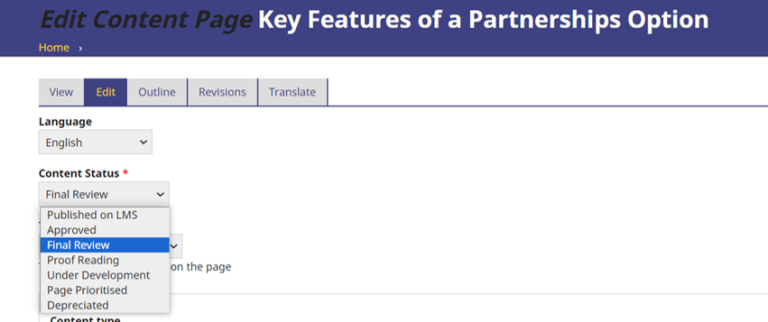
After identifying the desired content page, attention should be given to several parameters including content status, content type, page tags, content creator, and revision information. Before proceeding to translate HTML content to H5P or modify existing H5P content, it is crucial to ensure the correct content status is selected.
Further details on other parameters will be provided after explaining the content type.
Content Type (Course Presentations): H5P offers diverse content types catering to various interactive needs, facilitating easy creation of engaging materials. For detailed information, refer to https://h5p.org/content-types-and-applications. Our focus here is on course presentations, where we'll create interactive slides to enhance engagement and learning.
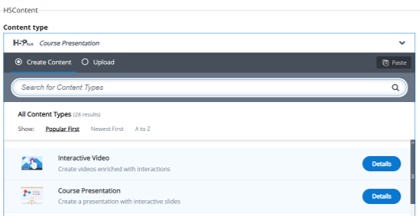
Ensure that the HTML content utilizes course presentations, with each presentation containing a maximum of 7 slides. If accordion or column formats have been used previously, maintain them without making any alterations.
Below is a thorough guide to assist you in creating or editing content pages while ensuring they meet the required standards:
| S.No | Parameters | Description |
|
1. |
Font Size |
Content title: 100% (Bold) Image

Image
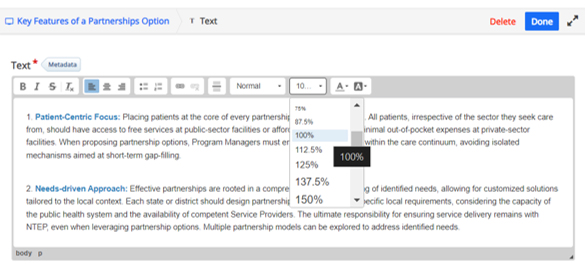
|
|
2. |
Margin |
1 cm (as indicated by the red lines in the content page provided) Image

|
|
3. |
Color Scheme |
Blue (sharp blue), orange (carrot) or green (emerald green) Image
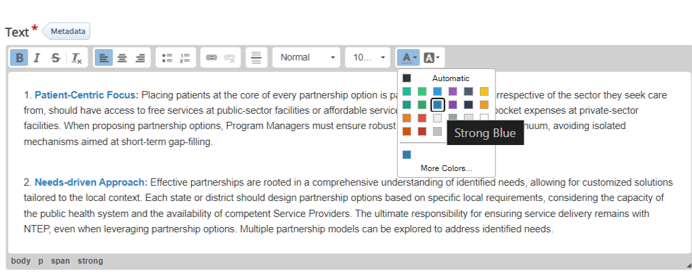
|
|
4. |
Videos |
Download the videos embedded within the HTML content and then upload them onto the course presentation for integration. Image

Image
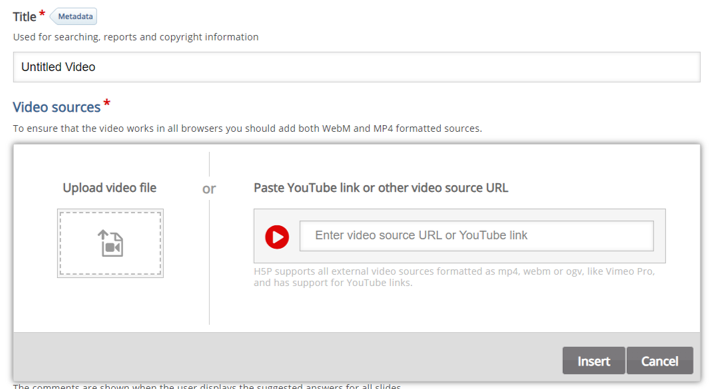
|
|
5. |
Infographic |
Image

Image
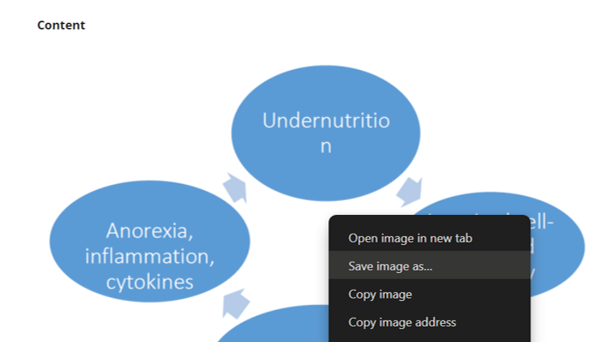
For new infographics, if the text isn't clear on existing figures, utilize templates available at https://www.presentationgo.com/ . Upload only the image of the template (e.g., triangle, hexagon) to the H5P software. Add text separately on H5P after uploading the template image. Image
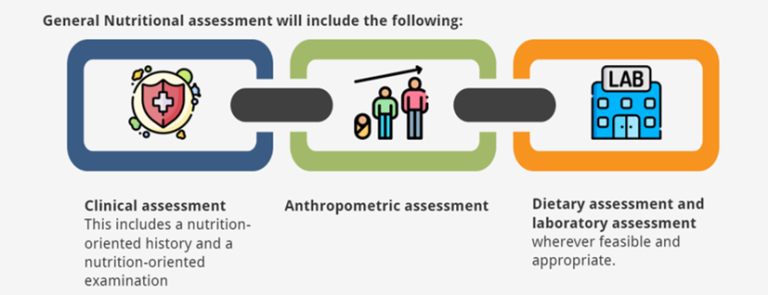
Note: |
|
6. |
Icons |
You have the option to use https://www.flaticon.com/ for icons. Additionally, you can employ separators like horizontal or vertical lines to distinguish content text from the icons. Image
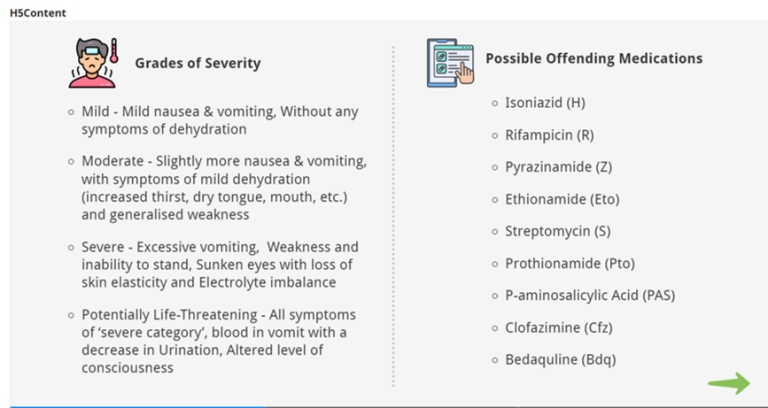
|
Language Guide
Language GuideThe Language guide is primarily extracted from the 'Words Matter' document (Second Edition published by StopTB Partnership in 2022, https://conf2022.theunion.org/wp-content/uploads/2022/05/stbp_words-mat…). Its use has been envisioned to guide the accommodation of inclusive language for TB training & communication while developing & reviewing course content under the Modernised Training System. Categorized into 'Alternatives', 'To be Carefully Used' and 'Emerging Terms', the guide underlines terms that 'must be replaced or alternatives that are sensitive and inclusive, use of terms that must be re-considered and other emerging terms in TB.
Alternatives
|
Use |
Replace |
Comments |
| They/them | He/him, She/her | More inclusive & gender sensitive |
| Contact Person | TB Contact | Does not have strong negative connotations but is not person-centered |
| Person Lost to Follow Up | Defaulter | Unnecessarily and unfairly places blame on the person receiving treatment |
| Noncitizen resident or Unauthorized resident/worker | Illegal/Alien worker | Offensive & isolates their access to TB treatment & care |
| Person with presumed TB | TB Suspect | Negative association |
| TB Prevention & Care or Ending TB | TB Control | Its continued use is no longer recommended by the World Health Organization (WHO) not people-centered, ignores contributions of communities & people affected by TB, -ve connotations of TB authorities as being in full control of all aspects of prevention, treatment & care |
| PLHIV/AIDS PLHWA/Person living with HIV | AIDS Patient | Necessary to reflect the fact that an HIV-positive person may continue to live well and productively for many years |
| Person Living with HIV/AIDS | Innocent Victim | The term wrongly implies that people infected in other ways (other than those infected medically or at birth through no fault of their own) are somehow guilty. |
| Person/s with physical disability | physically challenged | The term ‘physically challenged’ is deemed inappropriate as it places focus on the identity rather than the person & their barriers |
To be carefully used
|
Use |
Use carefully |
Comments |
| Person with presumed TB | Presumed Presumptive | The term ‘Presumed Presumptive’ places emphasis on the disease and not the person with possible tuberculosis. While, it can be used to describe a stage in the process of diagnosing TB, when discussing an individual, it is best to say a person with presumed TB |
| Burden | It should be stressed that it is the disease, not the people affected by the disease, that burdens a country, a region or the world | |
| Case Finding/Case Detection | Activity occurs by virtue of action taken by the person experiencing symptoms | |
| People deprived of their liberty | Prisoner/Inmate | An alternative can be ‘People deprived of their liberty’ (in some contexts it can stigmatize people and can impact perceptions regarding the right to health for all |
| Compliance, Non-Compliance | Noncompliance unfairly assigns blame to the person receiving treatment when many external factors outside a person’s control may be the cause | |
| Adherent/Nonadherent | Unfairly assigns singular responsibility for treatment completion to the person receiving treatment, when many external factors outside a person’s control | |
| Mobile Worker | Refers to a large category of persons who may cross borders or move within their own country on a usually frequent and short-term basis for a variety of work-related reasons, without changing their primary residence or home base | |
| Bacteriologically +ve/-ve | Sputum/Smear Positive/Negative | Smear microscopy is no longer recognized as a recommended diagnostic strategy. The preferred term is bacteriologically positive/ negative |
| Key and Vulnerable Population | Risk Groups | While the term is used in the epidemiology of TB to describe clinical risk groups when discussing an individual or group, it is best to say key and vulnerable populations . |
| Person Affected by TB/Person on Treatment/Client | Patient/TB Patient | Patient/TB Patient ‘clinicalizes’ them and focuses on the treatment process rather than the person |
Emerging Terms
|
Terms |
Definition |
| COVID-19 | An infectious disease caused by the SARS-CoV-2 virus. COVID-19 was first reported to the WHO on 31 December 2019 |
| Bi-Directional Testing | The delivery of simultaneous diagnostic testing for more than one disease |
| COVID-19 Response Mechanism (C19RM) | A special initiative of the Global Fund to Fight AIDS, TB and Malaria to provide countries with additional funding to respond to COVID-19 to mitigate its impact on HIV, TB and malaria programs and to initiate and strengthen improvements in health and community systems |
Setting learning objectives
Setting learning objectivesThis document outlines the principles for stating learning objectives for each KM Node.
Following are the steps for defining learning objectives.
- Clearly outline the anticipated outcomes that learners will be able to demonstrate after engaging with each page.
- The learning objectives should be stated such that it correspond to these outcomes. It should guide what the content page should represent. Specify what learners will be able to do, ensuring that objectives:
- clearly defined or describes an action
- are measurable
- Ensure that objectives are learner-centric, focusing on the behaviors that learners should adopt after going through the content, rather than focusing on what the page will “teach”
- Incorporate action words from the Modified Bloom’s Taxonomy (see reference table below).
- Choose an action word from the various levels of objectives (Knowledge, Comprehension, Application, Analysis, Synthesis, Evaluation) when formulating learning objectives, aligning them with the educational activity's overarching goal.
- Refrain from using vague terms like understand, learn, and know, as they lack measurability due to the absence of tangible outcomes.
Bloom’s Taxonomy of Measurable Verbs:
Benjamin Bloom devised a taxonomy of measurable verbs to facilitate the description and categorization of observable knowledge, skills, attitudes, behaviours, and abilities. This theory posits that there exist discernible levels of observable actions indicative of cognitive activity within the brain. Through the utilization of measurable verbs in crafting learning objectives, the explicit actions required to demonstrate learning are articulated.
Table 1: Measurable verbs
|
Category |
Meaning |
Verbs |
||
|
Knowledge |
Remember previously learned information. |
Arrange Choose Cite Define Describe Draw Enumerate Identify Indicate Label List
|
Locate Match Name Order Outline Quote Read Recall Recite Recognize Record
|
Relate Repeat Reproduce Review Select State Study Tabulate Tally Tell Underline Write |
|
Comprehension |
Demonstrate an understanding of the facts. |
Articulate Associate Characterize Clarify Classify Compare Compute Contrast Convert Defend Describe Differentiate Discuss Distinguish Estimate Example |
Explain Express Extend Extrapolate Factor Generalize Give Give examples Identify Illustrate Indicate Infer Interpolate Interpret Locate Match Observe |
Organize Paraphrase Predict Recognise Relate Report Represent Restate Review Rewrite Select Summarize Tell Translate
|
|
Application |
Apply knowledge to actual situations. |
Acquire Act Adapt Apply Ascertain Assign Avoid Back Back up Calculate Capture Change Chart Choose Classify Complete Compute Construct Consult Convey Customise |
Demonstrate Develop Discover Dramatize Derive Employ Experiment Explain Execute Generalize Guide Identify Illustrate Implement Interpret Interview Manipulate Modify Obtain Operate Organize |
Paint Perform Practice Predict Prepare Produce Process Provide Relate Schedule Select Show Simulate Sketch Solve Translate Use Utilize Write |
|
Analysis |
Break down objects or ideas into simpler parts and find evidence to support generalizations. |
Administer Analyze Appraise Break Break down Calculate Categorize Chart Classify Compare Conclude Confirm Contrast Correlate Corroborate criticize Identify Illustrate Infer Inspect Debate |
Deduce Delegate Detect Diagnose Diagram Differentiate Discover Discriminate Dissect Distinguish Divide Document Ensure Establish evaluate Examine Experiment Figure Group Inventory Investigate |
Manage Monitor Order organize Outline Point out Predict Prioritize Question Reconcile Relate Resolve Select Separate Solve Subdivide Survey Test Transform Troubleshoot |
|
Synthesis |
Compile component ideas into a new whole or propose alternative solutions. |
Anticipate Appraise Argue Arrange Assemble Assess Brief Attach Choose Collect Compare Compile Conclude Consolidate Construct Contrast Core Counsel Create Criticize Critique Decide
|
Defend Describe Depict Design Develop Determine Discriminate Enhance Estimate Evaluate Explain Facilitate Formulate Frame Generate Grade Handle Invent Judge Manage Mediate Modify
|
Organise Prepare Prescribe Probe Propose Rate Rearrange Reconcile Refer Relate Release Reorganise Revise Rewrite Select Set up Specify Supervise Synthesize Test Value Verify Weigh |
|
Evaluation |
Make and defend judgments based on internal evidence or external criteria. |
Appraise Argue Arrange Assemble Assess Categorize Choose Collect Combine Compare Compile Compose Conclude Construct Create Design Develop Devise Estimate Evaluate
|
Explain Facilitate Formulate Generalize Generate Hypothesize Improve Integrate Invent Judge Justify Make Manage Measure Modify Organize Originate Plan Predict Prepare
|
Produce Propose Rate Rearrange Reconstruct Relate Reorganize Revise Rewrite Role-play Score Select Set up Specify Summarize Support Synthesize Tell Tell why Value Write |